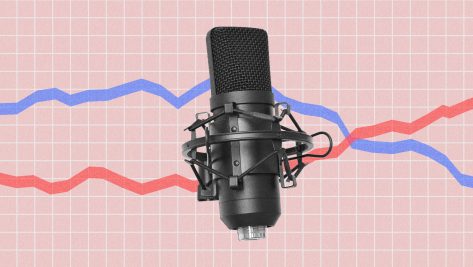In the United States, the day after Labor Day (a federal holiday and the first Monday of September) marks the time of year when it is no longer fashionable to wear white and also serves as the unofficial start of what former President Obama once called “political silly season.” The summer is over and so are most primaries, and this allows the general campaigns to get into full swing while the media and pollsters dive into their horse race predictions. This year is no different, except that a shift in the polls has taken place while we were busy sweltering in the summer heat: Democrats might evade massive losses in November. In fact, US Democrats could even gain a slim majority in the Senate and it’s possible—slightly possible but not probable—that they could hold on to the House of Representatives.
It’s widely understood that the party in the White House always loses the midterm elections. But actually, it’s not always the case. American voters do tend to correct the balance of power during midterm elections, but as with most so-called conventional wisdom, there are exceptions. A president’s party has gained in both houses just twice (Roosevelt in 1934 and Bush in 2002) and a handful have seen gains in one house. In other words, while the Republicans indeed go into the 2022 midterms with an advantage because the Democrats have the White House, the Democrats can still gain seats in one of the houses.
Another widely accepted phenomenon is that midterm elections are national referendums on the current president – and President Biden’s approval ratings have stunk since August of 2021. While it’s nice for Biden that his ratings have seen a small uptick since reaching the all-time low of 37.5% in July, but it’s important to note that this improvement comes from Trump, who has been inadvertently lending Biden a hand by doing what Trump does best: making everything about himself.
So, rather than being a referendum on Biden, this midterm is shaping up as a choice between Biden and Trump, although polling from Pew Research shows that few voters from either party see Biden as an important factor in this election. So, it doesn’t really matter that he’s unpopular. It’s more important that Democratic candidates benefit from this because, rather than being on their back foot defending Biden, they can talk up the issues their voters care about and go on the offensive against Trump and Trump candidates.
This can’t be overstated: the midterms are to elect all 435 seats of the House of Representatives and 35 Senate seats and these are won and lost in congressional districts and states across the country. Trump is not an opposition leader as he might be in a parliamentary system; he has no official job in the Republican Party but unofficially he continues to hold a lot of sway over voters and therefore over the party. He’s left his imprint on this midterm by backing anti-immigrant candidates who embrace 2020 election denialism in Republican primaries such as Dr. Mehmet Oz (widely known as the presenter of the TV show that bore his name) for Senate in Pennsylvania and Herschel Walker (former American football player) for Senate in Georgia. In fact, 60% of Americans will have a 2020 election denier on their midterm ballot.
All except one of the Trump-backed candidates won their primaries. But remember, congressional primaries are low turnout affairs that attract only the highly political party faithful. Now these candidates must face the general elections that involve more mainstream voters who do not think that the 2020 election was stolen from Trump. The Senate should have been a pretty easy pick-up for Republicans in this election since all they needed to gain was one seat. Yet this is not playing out and Senate Republican minority leader Mitch McConnell has even recognized that these Trump candidates are hurting the party’s chances of taking back the Senate. In August, he said, “There’s probably a greater likelihood the House flips than the Senate. Senate races are just different. Candidate quality has a lot to do with the outcome.”
In addition to Trumpy candidates, the Supreme Court decision on June 24th to strike down Roe vs. Wade, the landmark decision that made abortion legal in the U.S., is helping Democrats. Note this was struck down by a Supreme Court that Trump significantly shaped.
Gone are the days when Democrats had to shy away from talking about abortion.
It might seem counterintuitive that overturning Roe vs. Wade could help Democrats since it marked the culmination of decades of activism and the holy grail of Republican political achievements. However, there is a big difference between fighting for something and finally getting it.
Anger is political fuel and this decision stripped Republicans of their most emotional rallying cry and handed it over to the Democrats. Gone are the days when Democrats had to shy away from talking about abortion, now they can put it front and center to crank up the outrage machine. And this is already proving successful, a Democrat won a special House election in New York with abortion rights at the center of his campaign. And reliably red Kansas held a referendum in August with 59% voting to maintain abortion access. This has Democrats in other states scrambling to get abortion referendums on midterm ballots to drive voter turnout. There will be similar referendums in Michigan, California, and Vermont as well as Republican-backed referendums to further restrict abortion in Montana and Kentucky.
Another testament to how the issue of abortion rights has shifted is that some Republican candidates have been backing off from the hardline anti-abortion positions they embraced during the primaries. Some have gone so far as to scrub this language from their websites.
The shift in voters’ moods started to show up in the polls at the end of July-beginning of August, about a month after the Supreme Court decision, perhaps as people came to terms with the real-life implications of allowing states to ban abortion. Fivethirtyeight’s generic ballot—a poll that asks voters which party they prefer to control Congress—had favored Republicans since last November. Then Democrats polled evenly with them on August 3 and have since taken a 1.4-point lead.
Again, these elections take place in states and districts, so the Senate and House polling gives us a clearer picture of what is happening on the ground. Fivethirtyeight’s Senate forecast over time began to favor Democrats at the end of July and has risen dramatically since then. While Republicans are still favored to take the House, their numbers peaked in the forecast around July 13th at an 88% chance of controlling the House and has since fallen 19 points to a 69% possibility. It’s worth noting that these are forecasts – not polls – and this means that the model conversely shows that Democrats have a 31% chance of keeping the House and Republicans have a 34% chance of taking control of the Senate.
All leaders long to control the economy since they will inevitably be blamed for it.
While Trump had nothing to do with Biden’s string of legislative victories over the summer, it’s possible that they have helped to buoy Democrats in the polls. Biden signed the massive Inflation Reduction Act on August 16. This bill was passed through the budget reconciliation process which avoids the Senate filibuster. Democrats were able to secure the support of Senators Joe Manchin and Kyrsten Sinema, Democrats known for their moderate stances and penchant for holding up legislation. The act included wish list items for the party base, like the historic climate investment and the lowering of drug prices which should appeal to a wider swath of moderates.
The following week, the Biden administration announced their Student Loan Forgiveness Program that would cancel up to $20,000 in of federal student loans for millions of Americans saddled with debt they took on to finance their university educations. This was not only a major get for the party base, but is an immediate tangible – for some, life-changing – action that will especially benefit black, Latino, and young people.
Finally, all leaders long to control the economy since they will inevitably be blamed for it. Biden has had both good and bad luck with reining in inflation, which will be a big factor in winning over swing voters and has come down a bit since a high point in June. Even more important are gas prices, which also have fallen a bit since June and are always closely watched by Americans who are so dependent on their cars.
So, should Democrats start chilling the champagne? There’s still reason to be cautious. There is still some time to go and despite showing some positive numbers for Democrats, polls are not crystal balls. They simply provide a snapshot in time. Quite a bit can happen between now and November 8 that could push voters one way or another.
Underlying all of this is the structural advantage that Republicans have in Congress. Rural parts of the country that are mostly conservative are overrepresented because even tiny states get two senators and one representative. At the same time, the more left-leaning urban ones are underrepresented since the House has been capped at 435 members since 1929. This plus aggressive gerrymandering favors Republicans.
Finally, Democrats aren’t so good about going to the polls when a) they are confident or b) they aren’t in love with the candidate. Remember 2016? A significant number of Democrats didn’t like Clinton but were confident she would beat Trump, and so they stayed home. In 2020, it was the opposite: Democrats and a significant number of independents were so terrified of a second Trump term that they were voting no matter how little enthusiasm they had for Biden.
Midterms in the United States are tricky. Democrats always have to work harder than Republicans to prod their voters towards the polls and Republicans have made this even harder in some states by tightening identification requirements or restricting early voting and other programs designed to make it easier to cast ballots. This works in their favor, not just because these efforts mostly suppress voting by people of color (who tend to vote for Democrats) but also because Republicans don’t need to be in love with their candidates, they just get out and vote. So, even if polling is indicating that some of them might be balking at extreme candidates now, it would be foolish to think that they won’t vote or, worse, underestimate the intensity of voter support for Trump. In the end, the results will heavily depend on the ability of Democrats to get those ballots in the box and their best bet is to keep their voters terrified of the Trump-led Republicans.
A version of this article ran in Spanish in Esglobal.
© IE Insights.











